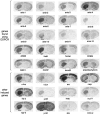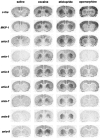A complex program of striatal gene expression induced by dopaminergic stimulation
- PMID: 9651213
- PMCID: PMC6793476
- DOI: 10.1523/JNEUROSCI.18-14-05301.1998
A complex program of striatal gene expression induced by dopaminergic stimulation
Abstract
Dopamine acting in the striatum is necessary for normal movement and motivation. Drugs that change striatal dopamine neurotransmission can have long-term effects on striatal physiology and behavior; these effects are thought to involve alterations in gene expression. Using the 6-hydroxydopamine lesion model of Parkinson's disease and differential display PCR, we have identified a set of more than 30 genes whose expression rapidly increases in response to stimulation of striatal dopamine D1 receptors. The induced mRNAs include both novel and previously described genes, with diverse time courses of expression. Some genes are expressed at near-maximal levels within 30 min, whereas others show no substantial induction until 2 hr or more after stimulation. Some of the induced genes, such as CREM, CHOP, and MAP kinase phosphatase-1, may be components of a homeostatic response to excessive stimulation. Others may be part of a genetic program involved in cellular and synaptic plasticity. A very similar set of genes is induced in unlesioned animals by administration of the psychostimulant cocaine or the antipsychotic eticlopride, although in distinct striatal cell populations. In contrast to some previously described early genes, most of the novel genes are not induced in cortex by apomorphine, indicating specificity of induction. Thus we have identified novel components of a complex, coordinated genetic program that is induced in striatal cells in response to various dopaminergic manipulations.
Figures






References
-
- Alberini CM, Ghirardi M, Metz R, Kandel ER. C/EBP is an immediate-early gene required for the consolidation of long-term facilitation in Aplysia. Cell. 1994;76:1099–1114. - PubMed
-
- Albin RL, Young AB, Penney JB. The functional anatomy of basal ganglia disorders. Trends Neurosci. 1989;12:366–375. - PubMed
-
- Brakeman PR, Lanahan AA, O’Brien R, Roche K, Barnes CA, Huganir RL, Worley PF. Homer: a protein that selectively binds metabotropic glutamate receptors. Nature. 1997;386:284–288. - PubMed
-
- Chase TN, Mouradian MM, Engber TM. Motor response complications and the function of striatal efferent systems. Neurology. 1993;43:S23–27. - PubMed
-
- Cole AJ, Bhat RV, Patt C, Worley PF, Baraban JM. D1 dopamine receptor activation of multiple transcription factor genes in rat striatum. J Neurochem. 1992;58:1420–1426. - PubMed
Publication types
MeSH terms
Substances
Associated data
- Actions
- Actions
- Actions
- Actions
- Actions
- Actions
- Actions
- Actions
- Actions
- Actions
- Actions
- Actions
LinkOut - more resources
Full Text Sources
Other Literature Sources
Molecular Biology Databases
Research Materials
